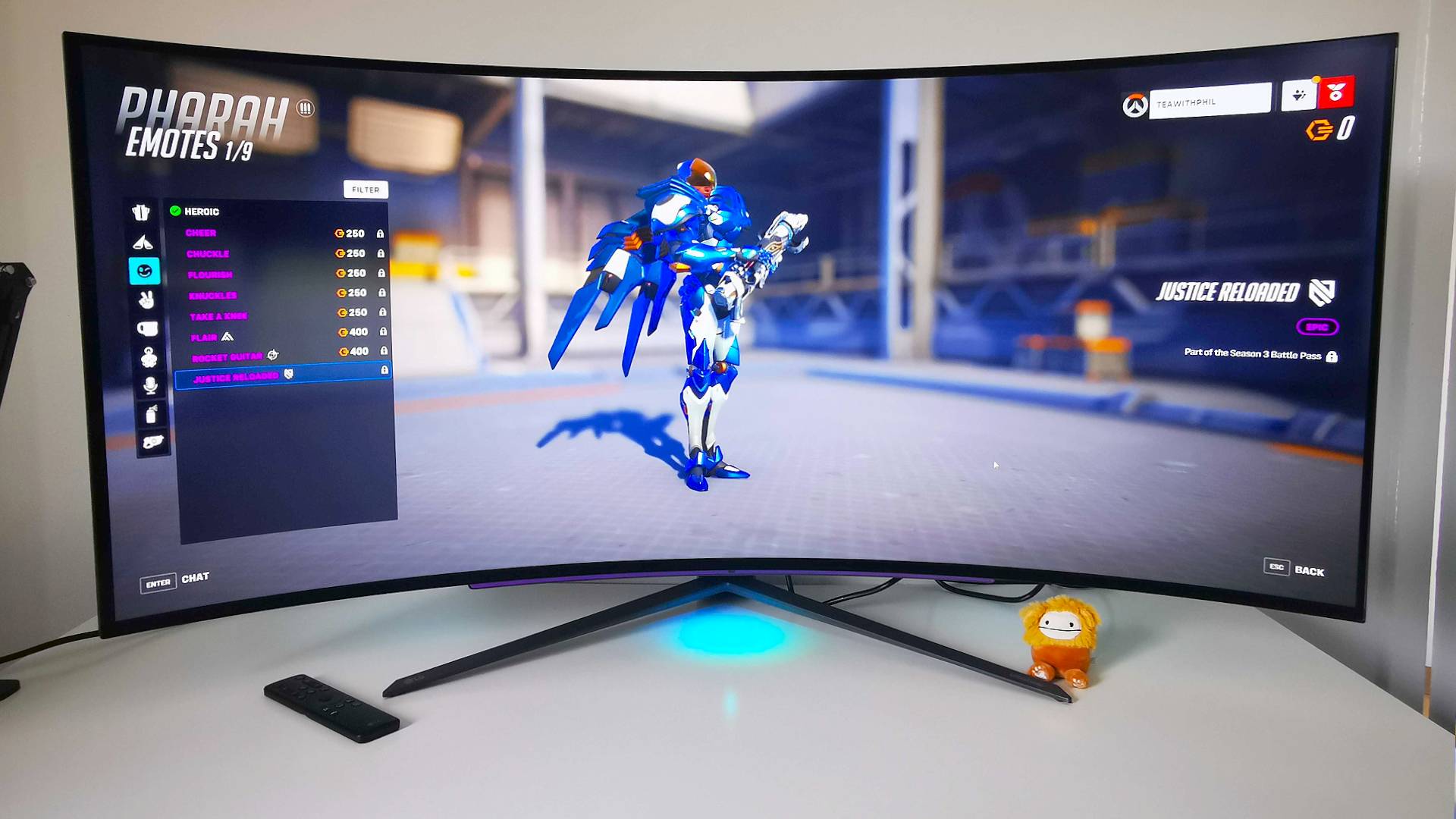GamesRadar+ Verdict
The LG UltraGear 45GR95QE-B is a brilliant ultrawide gaming monitor that'll dominate your desk, and its 800R curve serves to trick the senses. It's ridiculously pricey, and 4K fans may notice the difference with this 4K panel, but its OLED capabilities and arsenal of features almost justify its price tag. Just make sure you've got decent PC specs and plenty of space for this brute before parting with any cash.
Pros
- +
Gorgeous 45-inch OLED display
- +
Immersive ultrawide curve
- +
Effective RGB backlighting
Cons
- -
Beyond expensive
- -
1440p slightly soft at this screen size
Why you can trust GamesRadar+
I thought I knew what to expect before setting up the LG UltraGear 45GR95QE-B, but this gaming monitor has changed my whole opinion on ultrawide screens. That’s not to say I wasn’t into the idea before testing the curved OLED monster in question, but it’s now clear that large, engulfing panels can provide the kind of immersive experience you’d expect from a VR headset. Do I think 45-inches is overkill for a desktop screen? Well, yes, but it overwhelms my eyes in the best way possible with its colossal curves.
Admittedly, my opinion on the LG UltraGear 45GR95QE-B has changed since I wrestled with my initial unboxing. Initially, I scoffed at its ridiculous size, and my partner couldn’t quite understand why I’d swapped my usual gaming monitor out with ‘a weird shaped tele’. At a glance, that's exactly what this screen looks like, and it pretty much engulfs any spare space that used to exist on my gaming desk. Now that I’ve spent a few weeks with the display, I now feel like we owe LG’s panel an apology, as gaming TVs can only dream of matching its specs and abilities.
Priced at $1,699.99, the LG UltraGear 45GR95QE-B is almost expensive to a fault. Sure, the premium panel’s cost is matched with cutting edge features that punch harder than any screen I’ve tried, but it feels a bit mean spirited raving about a display that 99% of you out there can’t afford, and no amount of razzle dazzle can absolve it of its financial sins. Still, I’m going to delve into why it's one of the best curved monitors around and worth the hype, even if few of you out there will get to experience its glory first hand.
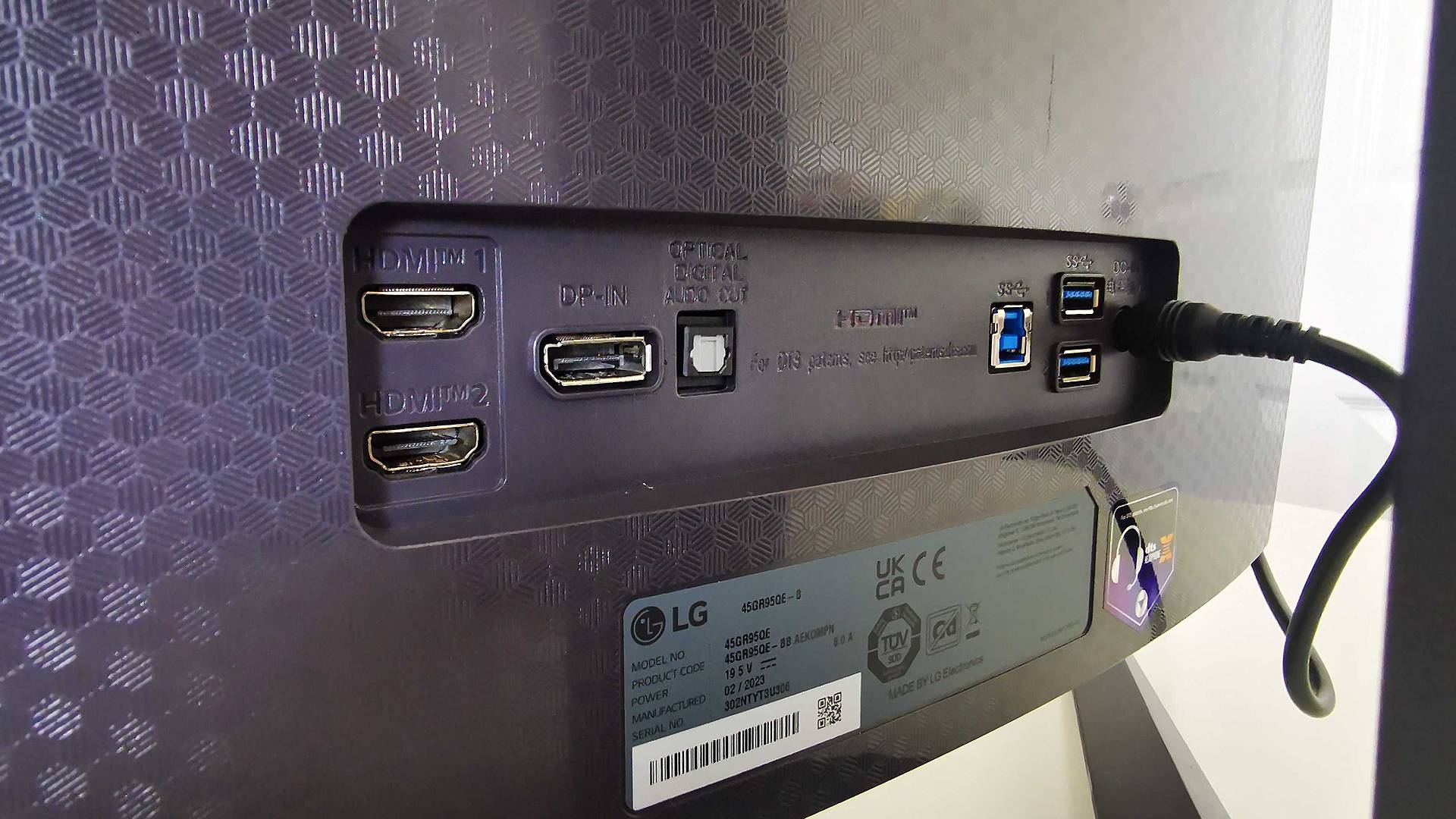
Specs
Dubbed the “world’s first 240Hz OLED monitor”, it’s clear that LG Ultragear 45GR95QE-B specs are out to impress. In fact, the 45-inch ultrawide display is probably one of the highest spec screens I’ve reviewed to date, though it trades 4K for WQHD (3440 x 1440) resolution.
| Price | $1,699 / £1,699 |
| Screen size | 45-inch |
| Screen type | OLED (800R curve) |
| Resolution | 3440 x 1440 |
| Brightness | 200 cd/m² |
| Response time | 0.03ms GtG |
| Viewing angle | 178° / 178° |
| Contrast ratio | 1,500,000:1 |
| Color support | 100% Adobe RGB, 98.5% DCI-P3 |
| Inputs | 2x HDMI 2.1, 1x Display Port 1.4, 2x USB-A, 3.5mm headphone, optical output |
| Weight | 24.03lbs (6.3Kg) |
Round the back, you’ll find two HDMI 2.1 ports, a DisplayPort, two USB Type A for hooking up your gaming PC peripherals, and an optical audio port. I’m actually a bit surprised to see a TOSLINK connector on the back, but it’s hardly surprising given LG’s TV heritage. However, I’m slightly confused at where they’d put the standard aux headphone out jack, as it took me about ten minutes to realise it’s left of the power button underneath. Probably more of a design complaint than a specs gripe, but having a rogue audio cable sticking out at the bottom of the monitor feels a little silly.
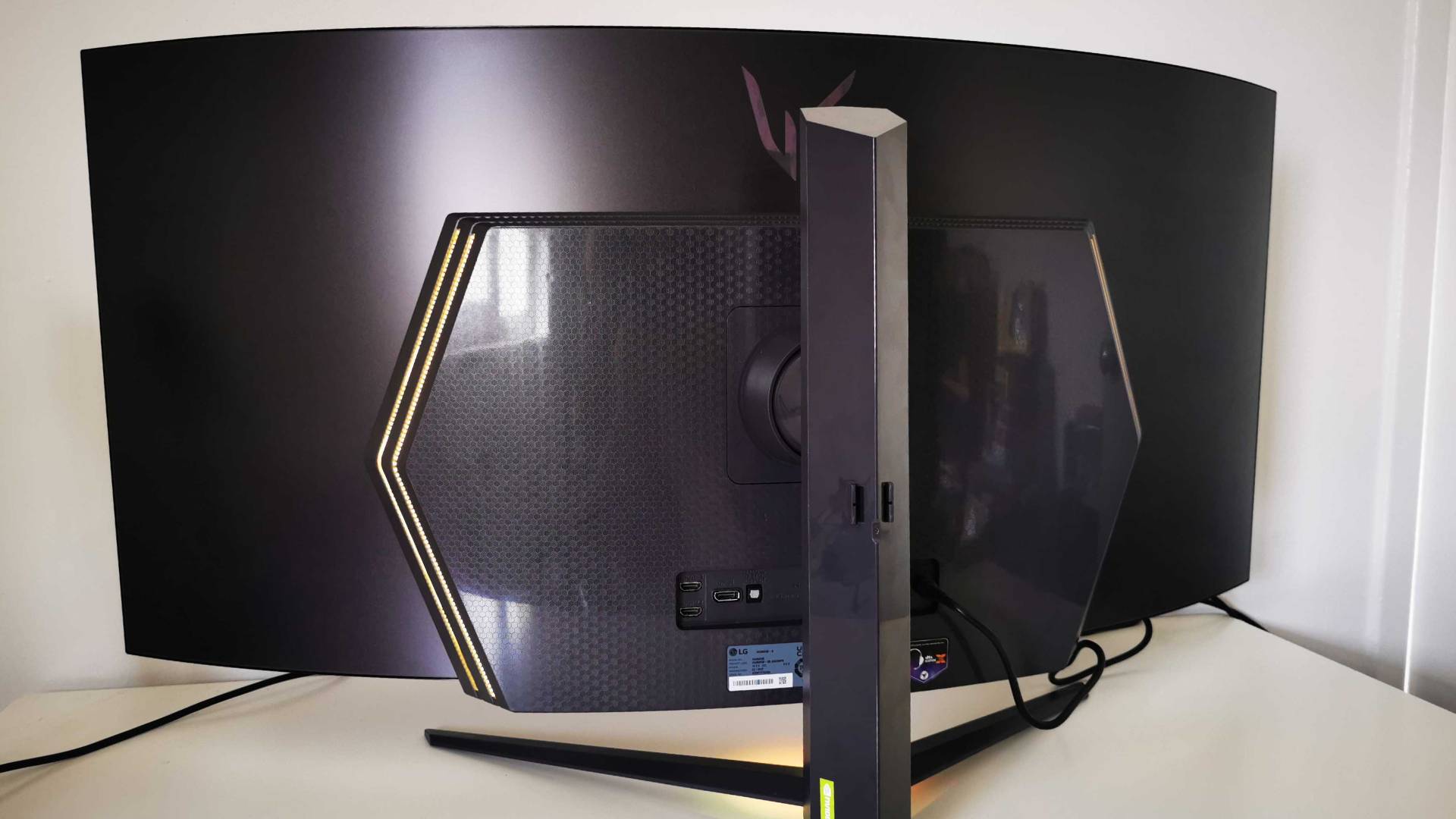
Design
Since we’re already chatting about the UltraGear 45GR95QE-B’s design, let’s delve into the screen’s overall setup, aesthetic, and layout. In case I’ve not already made it clear, 45-inches is gargantuan for a monitor, and you can tell it’s not a standard affair when taking it out of the box. If you do pick one up, make sure to have another human nearby to assist, as the screen’s wide stature and weight is a bit much for one person. I used to mount 55-inch plasma TVs on a supermarket wall as a job, and I even struggled a bit getting to grips with the display’s chonky design.
Thankfully, the 45GR95QE-B comes with a ‘one click stand’, meaning you’ll be able to attach the V-shaped base with ease. This is something I appreciated when carrying out our Corsair Xeneon 27QHD240 review, and I was more grateful for the design choice this time around. Once you’ve got it attached, you’ll be able to tweak things using the stand’s tilt, swivel, and height adjustments, which fill the brief but feel a tad stiff for my tastes.
Just like many expensive monitors in 2023, the UltraGear 45GR95QE-B is almost bezel-less, but still maintains a black border round the screen. Not that you’ll be thinking about that while using the display, as its sheer size and curved ultrawide shape will envelope you like no other screen can. At first, its dominating presence was a bit much, but I eventually managed to get into an eye rhythm. That’s not a technical term, I just don’t know how to describe the sensation of instructing your peepers to automatically navigate something in a specific way without feeling like they’re drowning in a sea of visual information.
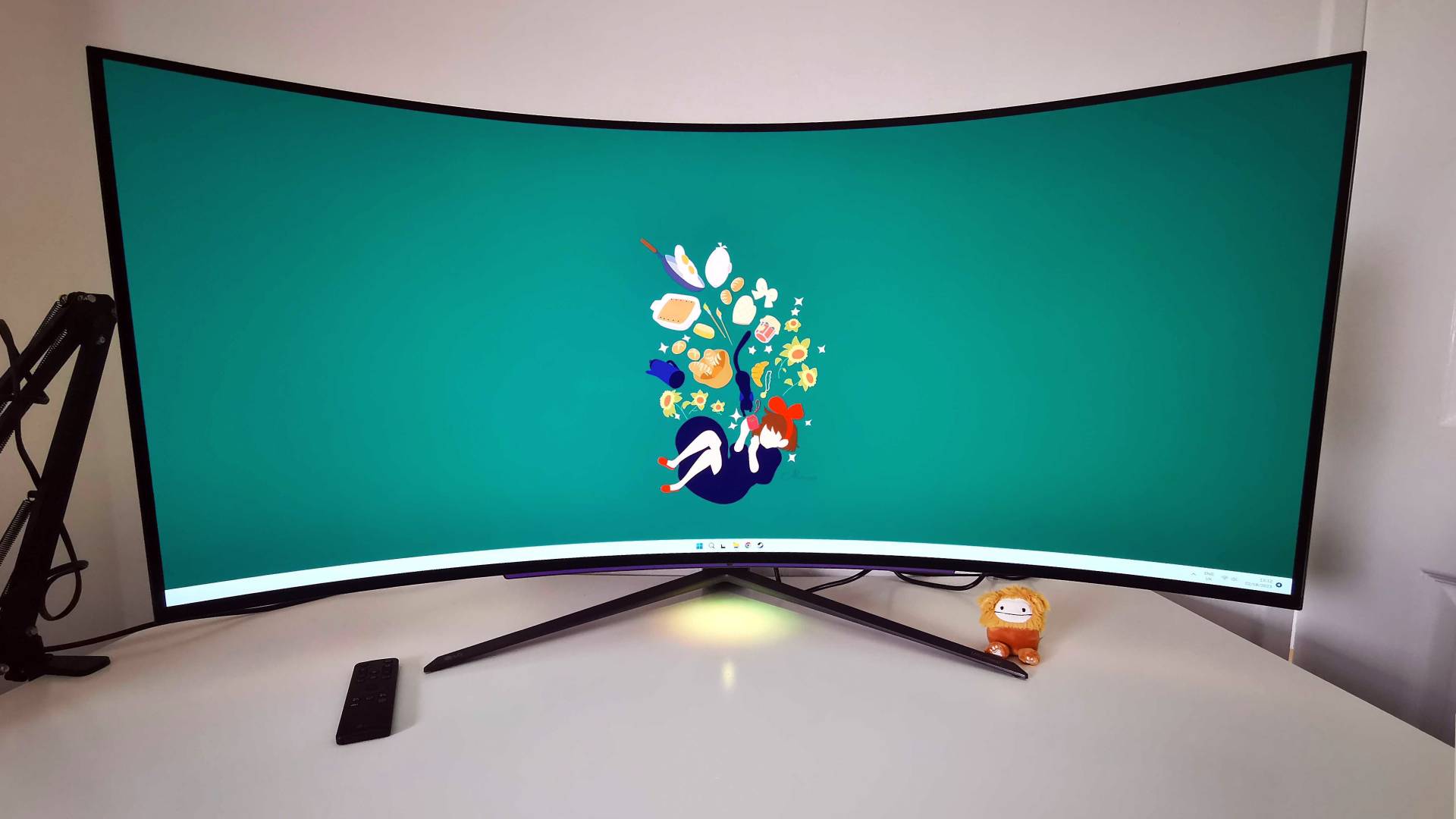
Features
It’s hard not to get distracted by the front of the monitor, especially since its 800R curved panel is like a gaping maw looking to gobble you up. Yet, it’s worth paying attention to the back, as LG has added some RGB lighting, hammering home the gamer aesthetic. This is nothing new, as screen’s like the BenQ Mobiuz EX3210U feature similar LED strips, but LG’s setup is actually bright enough to illuminate part of my wall, albeit when the room is dark.
The front power button also happens to be an RGB light, and it does a commendable job of painting my white desk with some rainbow underlighting. I’m not sure how much expense this adds to the monitor, but if it’s significant, I’d rather it was omitted to cut cost. However, it’s still the best attempt at monitor lighting I’ve seen so far, so even though it’s not exactly Philips Hue levels of impressive, it’s still praiseworthy.
Lighting isn’t the only feature shared by both the Mobiuz EX3210U and UltraGear 45GR95QE-B, as LG includes a remote with its display. Personally, I think every monitor should include a remote, as I find using OSD buttons on panels infuriating, and you’ll find yourself fishing through settings more than you’d think.
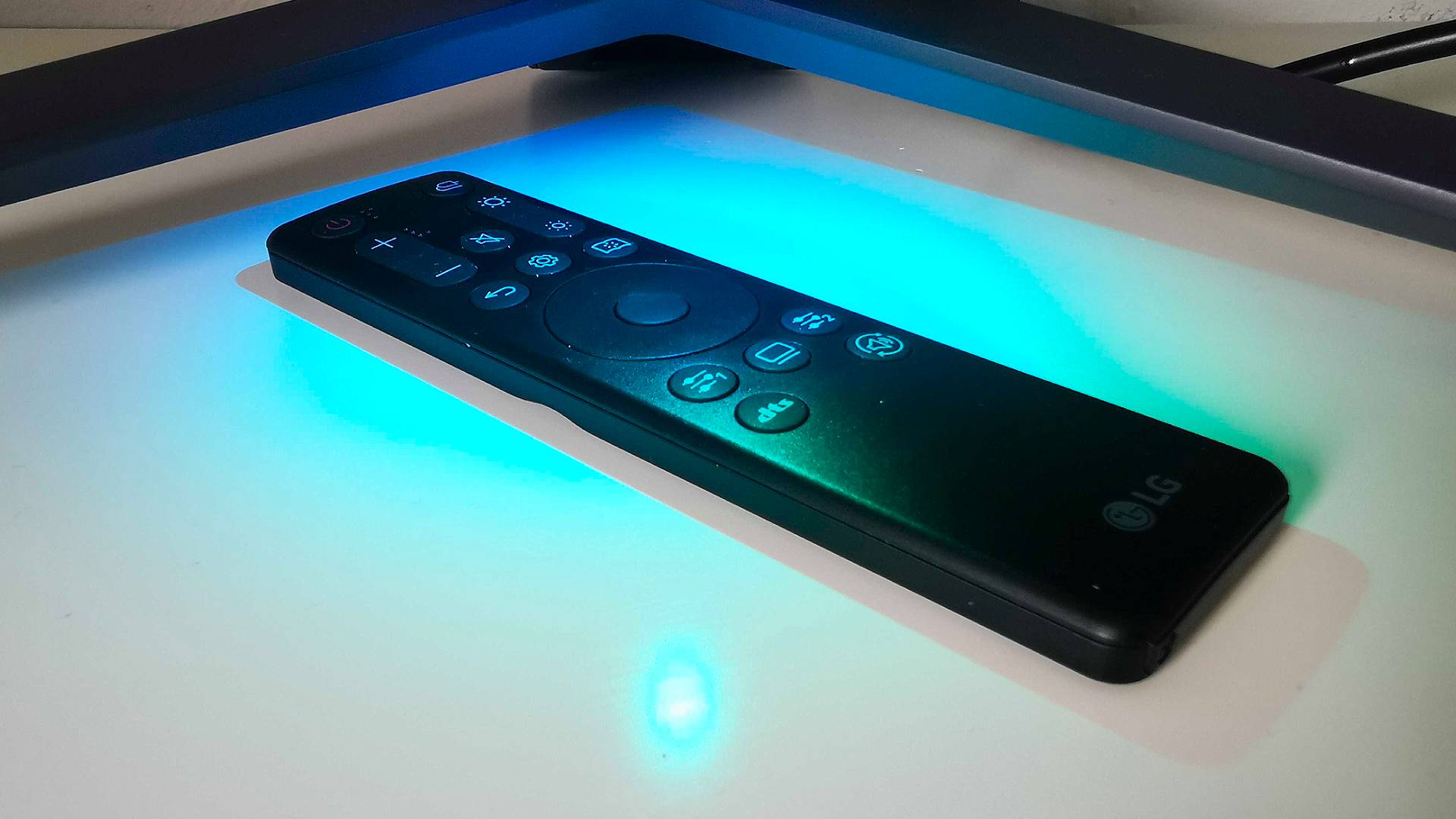
Speaking of settings, the UltraGear 45GR95QE-B has a healthy array of options within its sleek OSD menu, including various overlays, a toggle for Adaptive-sync (G-Sync compatible Freesync) settings, and ‘game mode’ presets. You’ll also be able to dial in contrast, gamma, and color settings if you’ve not got HDR switched on, and there’s picture in picture functionality too. That latter quirk is handy if you’re a streamer looking to use a console and Windows 11 on one screen, as you’ll be able to use two inputs at the same time.
For those of you terrified at the prospect of screen burn, you’ll be pleased to hear LG provides a whole separate menu for ‘OLED care’. While I'd need to test the display over a long period to tell if general use ghosting will occur over time, features like screen savers, image cleansing, and other preventive tools should prevent any rapid onset mishaps. I’d say I highly doubt anyone will burn this monitor, but you might want to be careful if you own an OSSC upscaler, as the retro console tool has a BOB deinterlacing setting that can cause temporary image retention within moments of use.
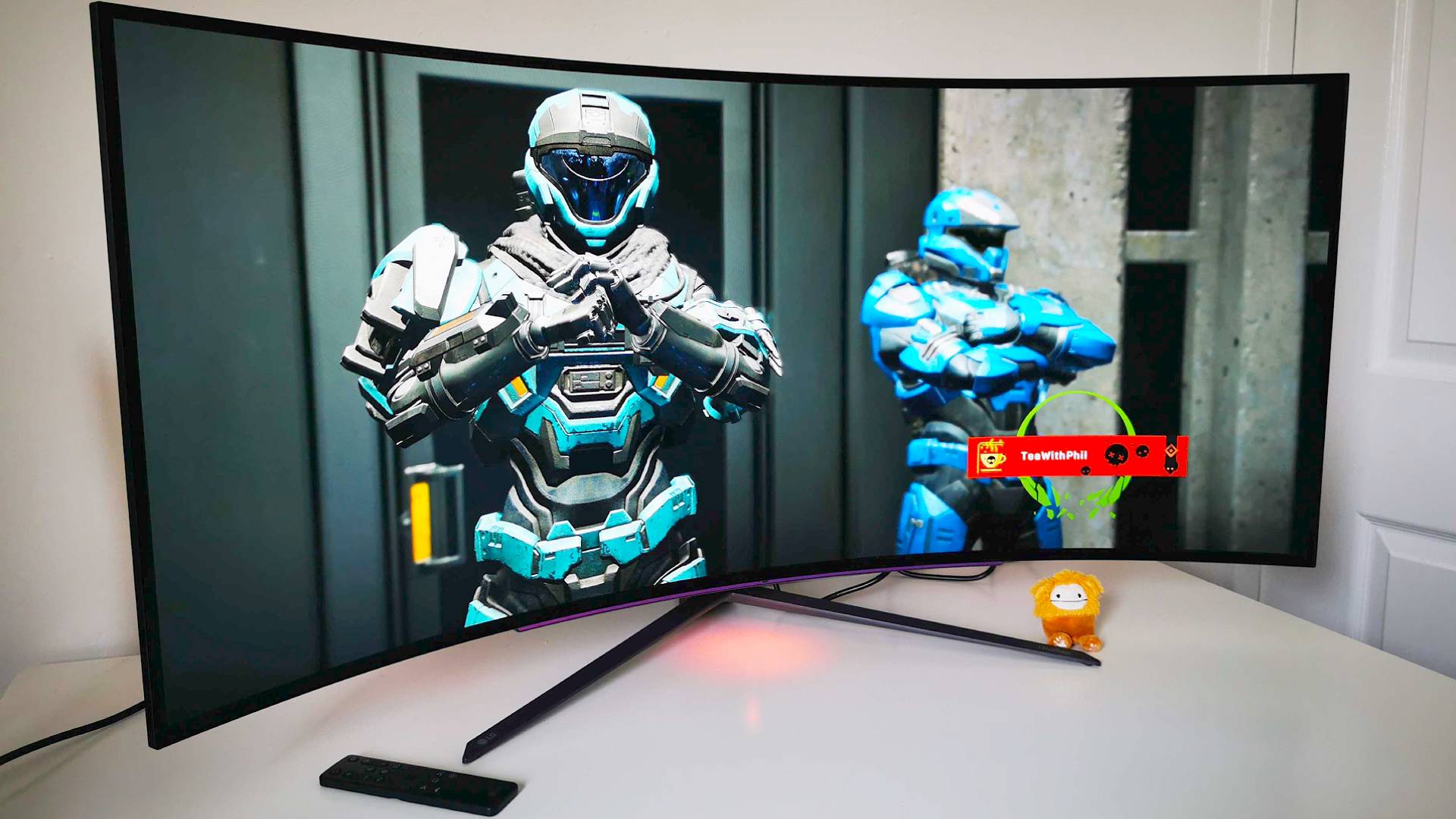
Performance
To put the UltraGear 45GR95QE-B’s capabilities to the test, and give LG’s incredible curvy OLED panel a chance to shine, I used the screen to visit my regular Steam haunts. My current go to game list includes Cyberpunk 2077, Overwatch 2, and the dystopian Tony Hawk shooter Rollerdrome, and the monitor sucked me into each world like a Jumanji board.
That said, I did experience some turbulence before landing in Night City, as I had my settings up a little too high for the Nvidia RTX 4060 currently residing in my rig to handle. In a way, I’m glad it happened, as it demonstrated the effects of inconsistent frame rates when using the monitor. I basically ended up feeling dizzy and sea sick, an effect I last felt when playing a VR game with iffy fps on the original Oculus Rift. All side effects of jittery visuals paired with the 800R curve, so you’ll want to double check settings before diving in.
Naturally, switching on DLSS 3 and adjusting settings helped balance Cyberpunk 2077, and the results were staggering. Just like with the Xeneon 27QHD240’s LG panel, the neon glow of Night City comes to life when paired with the company’s OLED tech and HDR 1000, and the 800R wrap-around effect really convinces your peripheral vision that you’re not dwelling at your desk. Not bad considering we’re talking about a monitor and not a headset like the Apple Vision Pro, even though the effect isn’t quite the same.
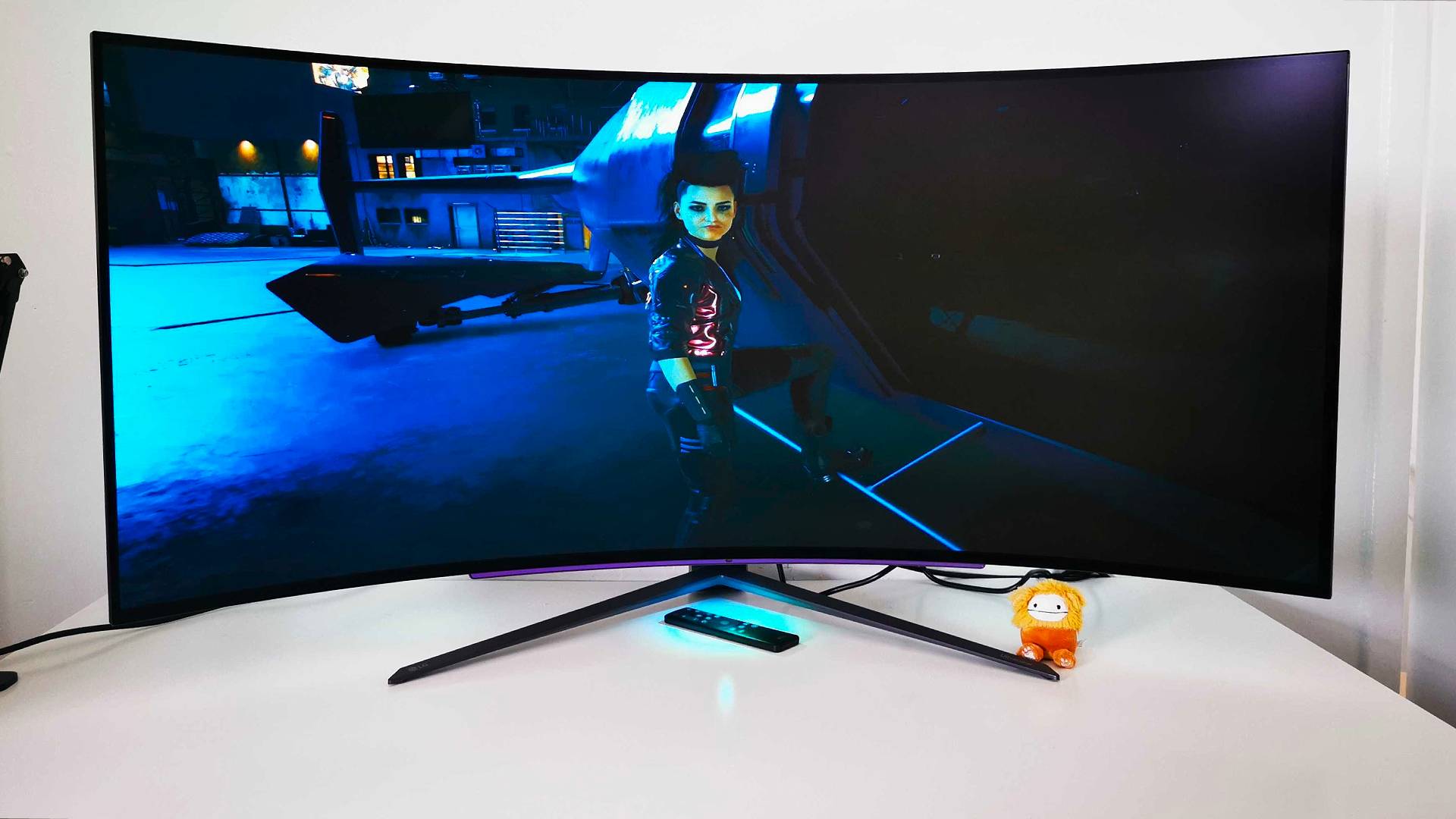
The UltraGear 45GR95QE-B’s 240Hz refresh rate is perfect for fast paced shooters, and while I’m hardly an esport pro, I felt like a bit less rubbish while playing Halo Infinite and Overwatch 2. Being able to clock enemy spartans at the every edge of the screen and spin quickly to engage is exhilarating, and raining justice from above as Pharah with a responsive, ultrawide view of the map absolutely slaps.
I’ve also been playing a bit of Tunic in short bursts, as nightly visits from a hungry fox outside reminded me it exists. It’s a lovely match for the 45GR95QE-B too, as the Zelda-link's vibrant palette pops on the curved display, and each level’s sprawling isometric layout rolls across the ultrawide screen nicely. I did sadly notice the difference in resolution compared to my usual 4K 144Hz setup when playing the indie adventure, and pixel density felt a bit lacking.
The bigger the screen, the more you’ll benefit from a higher resolution, and 1440p is perhaps pushing it a bit when it comes to the UltraGear 45GR95QE-B. If you sit a bit further away, you probably won’t notice the difference, but this curved, ultrawide display is begging you to sit close. I’d still argue QHD on this curved display is still passable, and this is more of a size mismatch issue.
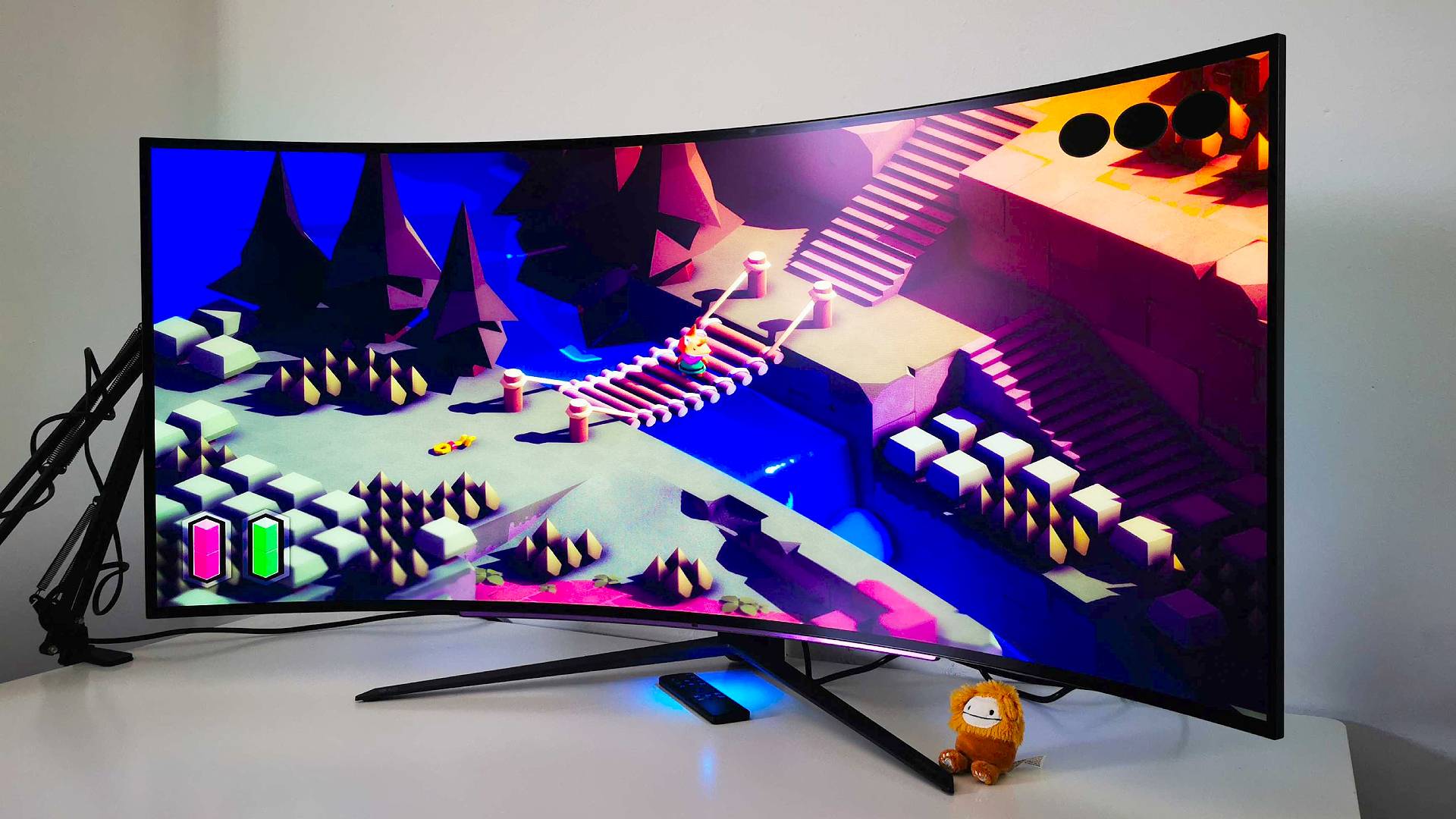
Should you buy the LG UltraGear 45GR95QE-B?
If you’re looking to go all out on a curved monitor with a superb OLED panel and excellent gaming abilities, the LG UltraGear 45GR95QE-B is a solid investment. That price tag will haunt the soul of any PC gamer on a budget, and its 45-inch stature draws attention to the fact it's 1440p. Nevertheless, LG’s big bold belter of a display is one of the best ultrawide monitors out there, and there are few like it that’ll soak your brain with immersive visual trickery.
Price will likely determine whether you actually buy the LG UltraGear 45GR95QE-B, and it’s certainly not a financially approachable experience. I’m also not sure if there’s a Venn diagram of players looking for a 240Hz screen and something the size of a TV, especially since it’s not designed to be played at a distance. But hey, maybe I’m wrong, and those closing thoughts don’t remotely change the fact that this monitor is top of the premium totem pole.
How I tested the LG UltraGear 45GR95QE
For three weeks, I used the LG UltraGear 45GR95QE as my daily driver for gaming and work-related shenanigans. This provided me with a chance to put the monitor’s ultrawide aspect ratio to the test in a practical setting as well as play numerous games with a high refresh rate. My selection of games this time around includes Cyberpunk 2077, Halo Infinite, Overwatch 2, and Tunic. I also hooked up a Steam Deck dock and the Ayaneo 2S to the monitor alongside my PC, which enabled me to use all three at the same time.
If you’d like to learn more about the way we test monitors and TVs, check out our GamesRadar hardware policy to learn more. Alternatively, feel free to reach out to me if you have any specific questions about the screen and the experience using it.
Looking for more speedy screens? Check out the best high refresh gaming monitors and boost your FPS game performance. Alternatively, take a peek at the best monitors for PS5 if you're after a console display.

I’ve been messing around with PCs, video game consoles, and tech since before I could speak. Don’t get me wrong, I kickstarted my relationship with technology by jamming a Hot Wheels double-decker bus into my parent’s VCR, but we all have to start somewhere. I even somehow managed to become a walking, talking buyer’s guide at my teenage supermarket job, which helped me accept my career fate. So, rather than try to realise my musician dreams, or see out my University degree, I started running my own retro pop culture site and writing about video games and tech for the likes of TechRadar, The Daily Star, and the BBC before eventually ending up with a job covering graphics card shenanigans at PCGamesN. Now, I’m your friendly neighbourhood Hardware Editor at GamesRadar, and it’s my job to make sure you can kick butt in all your favourite games using the best gaming hardware, whether you’re a sucker for handhelds like the Steam Deck and Nintendo Switch or a hardcore gaming PC enthusiast.
